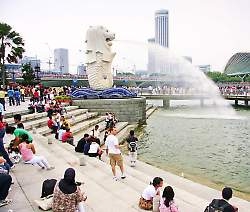Chinese tourism to Singapore triples during 2002-2012

SINGAPORE – More and more Chinese tourists choose to visit Singapore for longer time, with visit arrivals doubled and per capita expenditure tripled during the past ten years from 2002 to 2011.
According to official data from Singapore Tourism Board (STB), China was once the third largest in-bound market for Singapore in 2002, with only 670,000 visitor arrivals. But since 2003, China has become the second largest in-bound market, from which about 1. 578 million people visited Singapore last year, a dramatic increase of 35 percent from 2010.
“The growth momentum continued into 2012. Between January to May 2012, we received 856,000 visitors, registering a year-on-year growth of 30.7 percent, when compared with the same period last year.” Edward Chew, Chief Representative Regional Director of Greater China Region in STB told Xinhua.
During their stay in Singapore, shopping and accommodation are the two main expenditure items, typically making up about 70 percent of Chinese visitor expenditure.
“China has also consistently been one of our top five markets that generated the highest tourism receipts. In terms of per capita expenditure, this was about 1,337 Singapore dollars (1,087 U.S. dollars) in 2011, up from 467 Singapore dollars (380 U.S. dollars) in 2002.” Chew said, adding that the data has excluded the expenditures from sightseeing and entertainment due to commercial sensitivity of information.
Some industry insiders also mentioned that the consumption capacities of Chinese tourists have now exceeded those of Japanese. They seem to be the enthusiasts of some top-brand luxuries in Singapore.
China’s outbound tourists also pay more attention to the quality of their travels. Wu Na, Director of Meridian International Travel, said a lot of Chinese tourists she received now choose to stay in Singapore for more than one day rather than simple sightseeing when transiting to other countries.
She said the change are partly due to the tourism campaign conducted by Singapore’s government, but the preference for more leisure time and high-level travel experiences play more important role when Chinese people’s choose their travel plan nowadays.
The STB said travellers, especially those in the city-state’s key markets, are moving towards digital platforms when researching, planning and booking their trips. The majority of Chinese visitors to Singapore are predominantly free independent travellers who tend to go online to research for new experiences at a destination. This has been consistent over the last three years, with the ratio of free independent travellers and those on package tours at about 3:1.
Chew said Chinese visitors enjoy Singapore for its wide variety of international and local brands, as well as the lesser-known lifestyle enclaves such as Haji Lane and Arab Street.”Visitors seeking more in-depth experiences can also explore some of the lesser-known discoveries such as our lifestyle and cultural enclaves.”
Singapore has also implemented various measures to attract more Chinese tourists. Chinese people can easily get around the island without hassle by the country’s advanced transport system and infrastructure. The guideposts and introductions in mandarin and citizens who know more or less mandarin will provide convenience for most of Chinese visitors.
“There is a natural affinity for Chinese visitors to Singapore due to the cultural and language commonalities with Singapore’s majority Chinese population.” Chew said.
Besides facilitating visa issuance for more Chinese visitors, Singapore also operates more direct flights to China’s cities, reaching some second-tier and third-tier cities. In this August, the Scoot Airways began its route to Tianjin, following the future plans to fly directly to the cities of Qingdao and Shenyang.
In addition, Singapore is a destination that is constantly evolving with new attractions coming into the market such as the recently opened Gardens by the Bay and upcoming Marine Life Park and River Safari.
A calendar of events held throughout the year also keeps the Chinese audience engaged with Singapore. These include a line-up of signature events such as the World Gourmet Summit, Great Singapore Sale, Formula One and Christmas in the Tropics, which continue to attract both first time and repeat visitors to Singapore.
“We expect travel patterns to be impacted by economic concerns and the growth could potentially slow down. However with the strong travel potential seen in China’s outbound figures, we are optimistic that we will continue to see a strong flow of visitors from China to Singapore.” Chew added. Source: Xinhua















